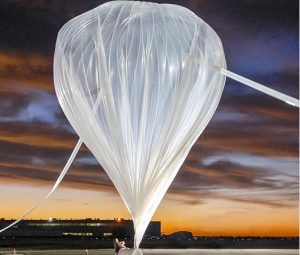NASA TechRise Student Challenge
What: NASA TechRise Student Challenge 2022/23
Who: Middle and high school students
Prizes: 60 winning teams will each receive $1,500 to build their experiment and an assigned spot on a NASA-sponsored high-altitude balloon flight
Deadline: Submit experiment ideas by Oct. 24, 2022
Lee esta nota de prensa en español aquí.
NASA and Future Engineers have teamed up again to launch the NASA TechRise Student Challenge 2022/23, a hands-on experience that offers insight into the design and test process used by NASA-supported researchers and aims to inspire a deeper understanding of Earth’s atmosphere, surface features, and climate, as well as space exploration, coding, electronics, and the value of test data.
This year’s challenge is focused on designing experiments to be tested exclusively on high-altitude balloons.
For decades, high-altitude balloon platforms have catalyzed fundamental discoveries that contribute to our current understanding of the Earth, the solar system, and the universe. And now, 6th – 12th graders attending U.S. public, private, or charter schools – including those in U.S. territories – can not only gain invaluable hands-on experience but also contribute new ideas and approaches that could help drive the future of space technology research! How? By designing their own experiment, in teams, to be conducted on a NASA-sponsored high-altitude balloon flight test.

A total of 60 winning teams will be selected to turn their proposed experiment idea into reality and launch their technology on a suborbital flight test. The winning teams will each receive $1,500 to build their experiment and an assigned spot on a NASA-sponsored high-altitude balloon flight operated by one of two commercial providers: Aerostar of Sioux Falls, South Dakota, or World View based in Tucson, Arizona.
Both high-altitude balloons provide exposure to the stratosphere at altitudes of approximately 9-19 miles (15-30 kilometers) and variable duration of flight time of hours to days.
The winning teams will also receive technical support and mentorship from Future Engineers, including the opportunity to learn or improve technology skills such as soldering, coding, and 3D design. NASA encourages students and their instructors to submit experiment ideas even if they have no prior experience with these activities.
The challenge is led by NASA’s Flight Opportunities program, which rapidly demonstrates technologies for space exploration and the expansion of space commerce through suborbital testing with industry flight providers.
Last year’s NASA TechRise 2021/22 winners are currently building experiments to test concepts including how methane reacts with other pollutants in the troposphere, and whether airline passengers should wear sunscreen. The sky is by no means the limit with what they could dream up and we want as many students as possible to get the chance to enter this challenge.
“We could not do a project like this in our classroom without the support of NASA TechRise,” said Jill Davis, Superintendent-Director of the Greater Lowell Technical High School in Tyngsborough, Massachusetts, which had one of the winning teams in last year’s challenge. “It is something that is truly out of this world! This challenge helped students develop their own unique ideas for future inventions, which adds a new layer of meaning to what they learn.”
For details and submission guidelines, please visit https://www.futureengineers.org/nasatechrise.
NASA plans to announce the competition winners in January 2023. The selected student teams will build their payloads from January to May, and the final experiments will take flight in summer 2023.
NASA’s Flight Opportunities program, based at the agency’s Armstrong Flight Research Center in Edwards, California, and part of NASA’s Space Technology Mission Directorate (STMD), is leading the NASA TechRise Challenge, with support from the NASA Tournament Lab, also part of STMD.
Filed under: Competitions and Contests, K-12 Outreach Programs, Special Features
Tags: Aerospace, atmostpheric research, Competitions for Students, Contest, Engineering Design, Grades 6-8, Grades 9-12, high-altitude balloon, Information in Spanish, NASA, NASA TechRise Student Challenge, Pollution, space exploration








